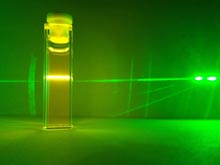
INFORMAZIONI GENERALI
Il Laboratorio di Spettroscopia Ultraveloce è complementare al Laboratorio di Fotochimica Supramolecolare del Dipartimento, e svolge attività di ricerca in stretta connessione con quest'ultimo laboratorio. Opera quindi, anche in collaborazione con numerose università straniere e italiane, su tematiche centrate sulla fotochimica, la chimica supramolecolare, la conversione chimica di energia solare, lo sviluppo di sensori luminescenti per varie applicazioni. L'attività di ricerca sperimentale include lo studio fotofisico di sistemi supramolecolari, macchine molecolari attivate dalla luce, e nuovi sistemi cromoforici, tramite tecniche spettroscopiche di assorbimento del transiente con risoluzione nel campo dei femtosecondi. Alcuni dettagli sulla attività di ricerca del Laboratorio sono riportati nel sito del Laboratorio di Fotochimica Supramolecolare. Nel Laboratorio di Spettroscopia Ultraveloce si svolge, inoltre, attività didattica relativa alla preparazione di tesi di laurea e di dottorato in Scienze Chimiche.


STRUMENTAZIONE ANNESSA
Il Setup per la Spettroscopia di assorbimento transiente pump probe, è costituito da:
-
una sorgente laser (MAI-TAI Spectra-Physics) Ti:sapphire in grado di generare impulsi laser a 800 nm con una frequenza di 1 kHz, energia pari a 1 mJ e 100 fs di durata;
-
un amplificatore parametrico (SPITFIRE - Spectra-Physics) pompato da un sistema laser a diodi EMPOWER Spectra-Physics;
-
un sistema di ottica non lineare Spectra-Physics 800 FP OPA per modulare e variare la lunghezza d’onda e l’intensità dell’impulso di pompa in un range fra i 350 nm ed i 1300 nm;
-
gli spettri di assorbimento transiente vengono registrati tramite uno spettrofotometro (che comprende linea di ritardo e generazione del bianco di probe) HELIOS Spectra Physics che permette di investigare un range spettrale compreso fra i 450 ed i 1600 nm e un range temporale pari a 0–3200 ps.
The Ultrafast Spectroscopy Lab: some information
Ultrafast spectroscopy is an interdisciplinary area of research that spans various disciplines in chemistry and provides essential information on the mechanistic and kinetic details of chemical events that occur in the timescale of 100 fs - hundreds of ps. The chemical events in these experiments are initiated by an ultrafast laser pulse (pump) and the photophysical and photochemical events are probed by another ultrafast laser probe pulse.
In the Ultrafast Spectroscopy Lab, time-resolved transient absorption experiments can be performed using a pump–probe setup based on the Spectra-Physics MAI-TAI Ti:sapphire system as the laser source and the Ultrafast Systems Helios spectrometer as the detector. The Mai-Tai delivers light pulses centered at 800 nm wavelength with 1 kHz repetition rate, energy of 1 mJ and 100 fs duration. A Spitfire amplifier contains the optics and opto-mechanical devices for stretching, selecting, amplifying and compressing pulses from the Mai-TAI seed laser pulse.
The light provided by these laser sources is then manipulated by linear and nonlinear optical processes on a Spectra-Physics 800 FP OPA instrument, broadening the spectral width, tuning the center wavelength, shaping the pulse temporal profile of the pump pulse.
The probe pulse can be obtained by continuum generation on a sapphire plate (spectral range 450–800 nm). The transient spectra are registered by using the Spectra-Physics HELIOS broadband pump-probe femtosecond Transient Absorption Spectrometer .
The effective time resolution is around 200 fs, and the temporal chirp over the white-light 450–750 nm range around 150 fs; the temporal window of the optical delay stage was 0–3200 ps. Beside the "conventional" systems for probing the 450-800 nm range, as NIR detector a fiber optics coupled multichannel spectrometer with InGaAs sensor can be used for near-infrared experiments probing the photoinduced transients in the 800-1600 nm range, with 3.5 nm intrinsic resolution (sensitivity range: 800-1600 nm; maximum spectral acquisition rate- 7900 spectra/s). All the time-resolved data are analysed with the Ultrafast Systems Surface Explorer Pro software.
With this pump-probe setup we can trace dynamics of excited state in organic or inorganic samples as well as hybrid matrices. The applications range from supramolecular photochemistry and artificial photosynthesis to molecular machines fields.

DOCENTI
Fausto Puntoriero (Responsabile);
Francesco Nastasi (Responsabile);
Scolastica Serroni;
Sebastiano Campagna;
Maurilio Galletta (Personale tecnico esperto).


